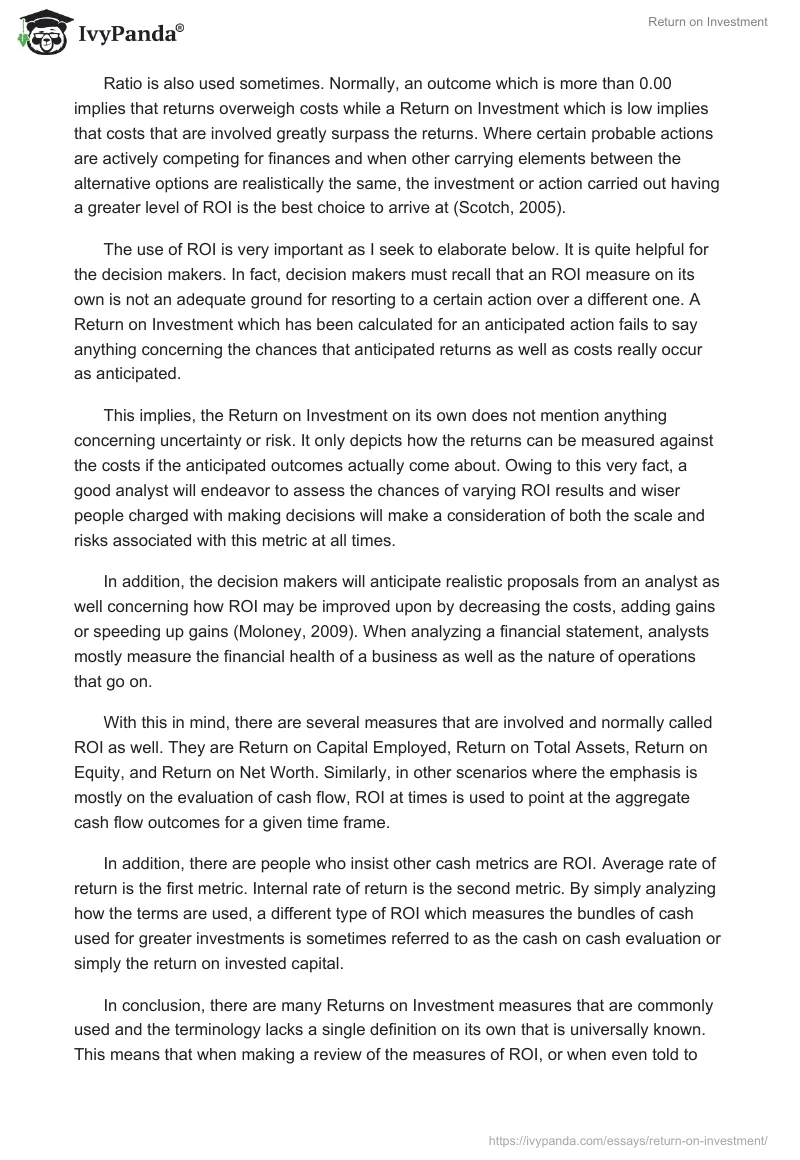Return on Investment (ROI) refers to a well-known financial metric commonly used to analyze the financial results which arise from personal investments as well as deeds. A number of varying metrics are basically known by the same definition. However, the most popular refers to a metric that I seek to discuss in this paper known as ROI.
Normally used as a cash flow metric, the Return on Investment particularly makes a comparison of the scale as well as scheduling of investment gains which are matched directly to the scale and scheduling of costs involved. In any situation where the ROI is seen to post a high rate, it implies that the gains which have been made compare well with the costs that had been incurred (Saleemi, 2006).
Return on Investment has grown into a well-known concept within the past few decades mostly as an all-purpose metric for analyzing capital attainments, business initiatives, and conservative fiscal investments. These investments are directed into stock shares or into venture capital use.
The issue of popularity however is not much important since the metric is commonly used by people without really understanding the merits and demerits that are associated with it. Return on Investments is used to measure how profitable a transaction is at times. This definition is very accurate as well as very important.
There are business men who make use of different metrics in economics instead of ROI to imply one and the same thing. Such use is potentially wrong and lacks knowledge since efficiency is a word that is similarly used to define a measure that is arrived at by using very few varying financial metrics such as Internal Rate of Return (IRR), Return on Capital Employed among others.
The inherent meaning in the metric, Return on Investment, is somewhat implied in how its naming is done. Return on Investment seeks to answer questions such as, what is that is attained for that which is spent, do the returns anticipated surpass the costs involved, and do the returns attained perfectly justify the costs used? Many types of ROI measure what is gained from a certain cost through a calculation.
Ratio is also used sometimes. Normally, an outcome which is more than 0.00 implies that returns overweigh costs while a Return on Investment which is low implies that costs that are involved greatly surpass the returns. Where certain probable actions are actively competing for finances and when other carrying elements between the alternative options are realistically the same, the investment or action carried out having a greater level of ROI is the best choice to arrive at (Scotch, 2005).
The use of ROI is very important as I seek to elaborate below. It is quite helpful for the decision makers. In fact, decision makers must recall that an ROI measure on its own is not an adequate ground for resorting to a certain action over a different one. A Return on Investment which has been calculated for an anticipated action fails to say anything concerning the chances that anticipated returns as well as costs really occur as anticipated.
This implies, the Return on Investment on its own does not mention anything concerning uncertainty or risk. It only depicts how the returns can be measured against the costs if the anticipated outcomes actually come about. Owing to this very fact, a good analyst will endeavor to assess the chances of varying ROI results and wiser people charged with making decisions will make a consideration of both the scale and risks associated with this metric at all times.
In addition, the decision makers will anticipate realistic proposals from an analyst as well concerning how ROI may be improved upon by decreasing the costs, adding gains or speeding up gains (Moloney, 2009). When analyzing a financial statement, analysts mostly measure the financial health of a business as well as the nature of operations that go on.
With this in mind, there are several measures that are involved and normally called ROI as well. They are Return on Capital Employed, Return on Total Assets, Return on Equity, and Return on Net Worth. Similarly, in other scenarios where the emphasis is mostly on the evaluation of cash flow, ROI at times is used to point at the aggregate cash flow outcomes for a given time frame.
In addition, there are people who insist other cash metrics are ROI. Average rate of return is the first metric. Internal rate of return is the second metric. By simply analyzing how the terms are used, a different type of ROI which measures the bundles of cash used for greater investments is sometimes referred to as the cash on cash evaluation or simply the return on invested capital.
In conclusion, there are many Returns on Investment measures that are commonly used and the terminology lacks a single definition on its own that is universally known. This means that when making a review of the measures of ROI, or when even told to come up with one, it is very pertinent that care is employed to ascertain that all the people involved are able to describe the measure in the same manner.
References
Moloney, T. (2009). Business Finance. New York: Sage Publications.
Saleemi, N. (2006). Economics in Practice. New York: Rout ledge Publishers.
Scotch, B. (2005). Business Management. London: Prentice Hall.


